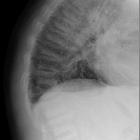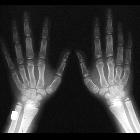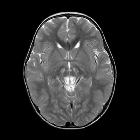Basalganglienverkalkungen



Basal ganglia
calcification • Basal ganglia calcification - senile - Ganzer Fall bei Radiopaedia

Basal ganglia
calcification • Basal ganglia calcification post chemotherapy - Ganzer Fall bei Radiopaedia

Basal ganglia
calcification • Basal ganglia calcification (x-ray) - Ganzer Fall bei Radiopaedia

Basal ganglia
calcification • Sanjad Sakati syndrome - Ganzer Fall bei Radiopaedia

Neuroimaging
assessment in Down syndrome: a pictorial review. Axial CT of a 46-year-old Down syndrome patient with basal ganglia calcifications, mainly involving the globus pallidus
Basal ganglia calcification is common and is seen in approximately 1% of all CT scans of the brain, depending on the demographics of the scanned population. It is seen more frequently in older patients and is considered a normal incidental and idiopathic finding in an elderly patient but should be considered pathological in persons younger than the age of 40 years unless proved otherwise .
However, there are many causes of calcification:
- idiopathic
- aging: common, globus pallidus most commonly affected
- Fahr disease
- toxic
- carbon monoxide poisoning
- lead poisoning
- mineralizing microangiopathy
- associated with radiation therapy and chemotherapy
- nephrotic syndrome
- infectious
- metabolic
- birth hypoxia
- inherited
- mitochondrial diseases e.g. MELAS
- Cockayne syndrome
- pantothenate kinase-associated neurodegeneration (PKAN) (also known as Hallervorden-Spatz syndrome)
- Down syndrome
- tuberous sclerosis
- methemoglobinopathy
- Sanjad Sakati syndrome
- vascular
- developmental venous anomaly (unilateral)
See also
Siehe auch:
- Morbus Fahr
- Globus pallidus
- Neurozystizerkose
- T2 hyperintense Basalganglien
- primärer Hyperparathyreoidismus
- Tuberkulose des ZNS
- Neurotoxoplasmose
- eye of tiger sign
- TORCH
- Pseudohypoparathyreoidismus
- Kohlenmonoxidintoxikation
- Neurodegeneration mit Eisenablagerung im Gehirn
- Mitochondropathie
- decreased T1 signal in the basal ganglia
- decreased T2 signal in the basal ganglia
- Cockayne-Syndrom
- basal ganglia signal abnormalities
- Mitochondriale Encephalomyopathie mit Lactatacidose und Schlaganfall-ähnlichen Episoden (MELAS)
- globus pallidus calcification
- Labrune syndrome
- AIDS
- increased T1 signal in the basal ganglia
und weiter:
- Putamen
- basal ganglia T1 hyperintensity
- Basalganglien
- Einblutung in die Basalganglien
- basal ganglia T2 hypointensity
- Nucleus caudatus
- hyperdense Basalganglien
- normale intrakranielle Verkalkungen
- signal abnormalities in the basal ganglia
- bilateral ganglia lesions
- basal ganglia calcification post chemotherapy
- Fried-Syndrom

 Assoziationen und Differentialdiagnosen zu Basalganglienverkalkungen:
Assoziationen und Differentialdiagnosen zu Basalganglienverkalkungen:Mitochondriale
Encephalomyopathie mit Lactatacidose und Schlaganfall-ähnlichen Episoden (MELAS)













